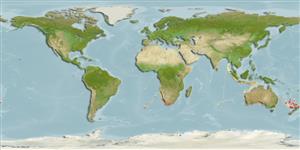Common names from other countries
Teleostei (teleosts) >
Gadiformes (Cods) >
Macrouridae (Grenadiers or rattails)
Etymology: Coelorinchus: Greek, koilos = a hollow + Greek, rhyngchos = jaw (Ref. 45335).
Environment: milieu / climate zone / depth range / distribution range
Ecology
Marine; bathydemersal; non-migratory; depth range 450 - 1000 m (Ref. 1371). Deep-water; - 40°S
Southeast Atlantic: South Africa. Western Pacific: southeastern Australia including Tasmania, also in New Zealand.
Size / Weight / Age
Maturity: Lm ? range ? - ? cm
Max length : 65.0 cm TL male/unsexed; (Ref. 1371)
Short description
Morphology | Morphometrics
Dorsal
spines
(total): 2;
Dorsal
soft rays
(total): 134-135;
Anal
spines: 0;
Anal
soft rays: 110. Head large; the eyes also large; the snout blunt, its anterolateral margin incompletely supported by bone. Head ridges with modified thickened scales but not specially spiny; the suborbital ridge well defined. The underside of the head entirely scaled except for the lips and the gill membranes. Light organ a small globular gland adjacent to the anus, not visible externally. Gray to grayish pink, with a conspicuous dark blue band around the abdominal area; the fins and gill membranes blackish (Ref. 1371).
Feeds on fishes (myctophids), and crabs, among other items (Ref. 1371).
Life cycle and mating behavior
Maturity | Reproduction | Spawning | Eggs | Fecundity | Larvae
Iwamoto, T. and E. Anderson, 1994. Review of the grenadiers (Teleostei: Gadiformes) of southern Africa, with descriptions of four new species. Ichthyol. Bull. J.L.B. Smith Inst. Ichthyol. (61):1-28. (Ref. 11953)
IUCN Red List Status (Ref. 130435)
CITES (Ref. 128078)
Not Evaluated
Threat to humans
Harmless
Human uses
Fisheries: minor commercial
More information
Common namesSynonymsMetabolismPredatorsEcotoxicologyReproductionMaturitySpawningFecundityEggsEgg development
Age/SizeGrowthLength-weightLength-lengthLength-frequenciesMorphometricsMorphologyLarvaeLarval dynamicsRecruitmentAbundance
ReferencesAquacultureAquaculture profileStrainsGeneticsElectrophoresesHeritabilityDiseasesProcessingMass conversion
Tools
Special reports
Download XML
Internet sources
Estimates based on models
Preferred temperature (Ref.
115969): 5.2 - 9.9, mean 8.5 (based on 81 cells).
Phylogenetic diversity index (Ref.
82804): PD
50 = 0.5000 [Uniqueness, from 0.5 = low to 2.0 = high].
Bayesian length-weight: a=0.00251 (0.00128 - 0.00492), b=3.19 (3.03 - 3.35), in cm Total Length, based on LWR estimates for this Genus-body shape (Ref.
93245).
Trophic level (Ref.
69278): 3.5 ±0.48 se; based on food items.
Resilience (Ref.
120179): Very Low, minimum population doubling time more than 14 years (Preliminary K or Fecundity.).
Fishing Vulnerability (Ref.
59153): Moderate to high vulnerability (46 of 100).
